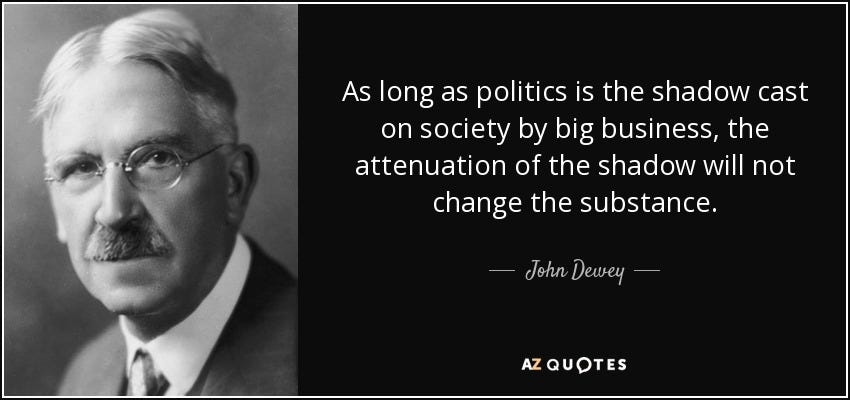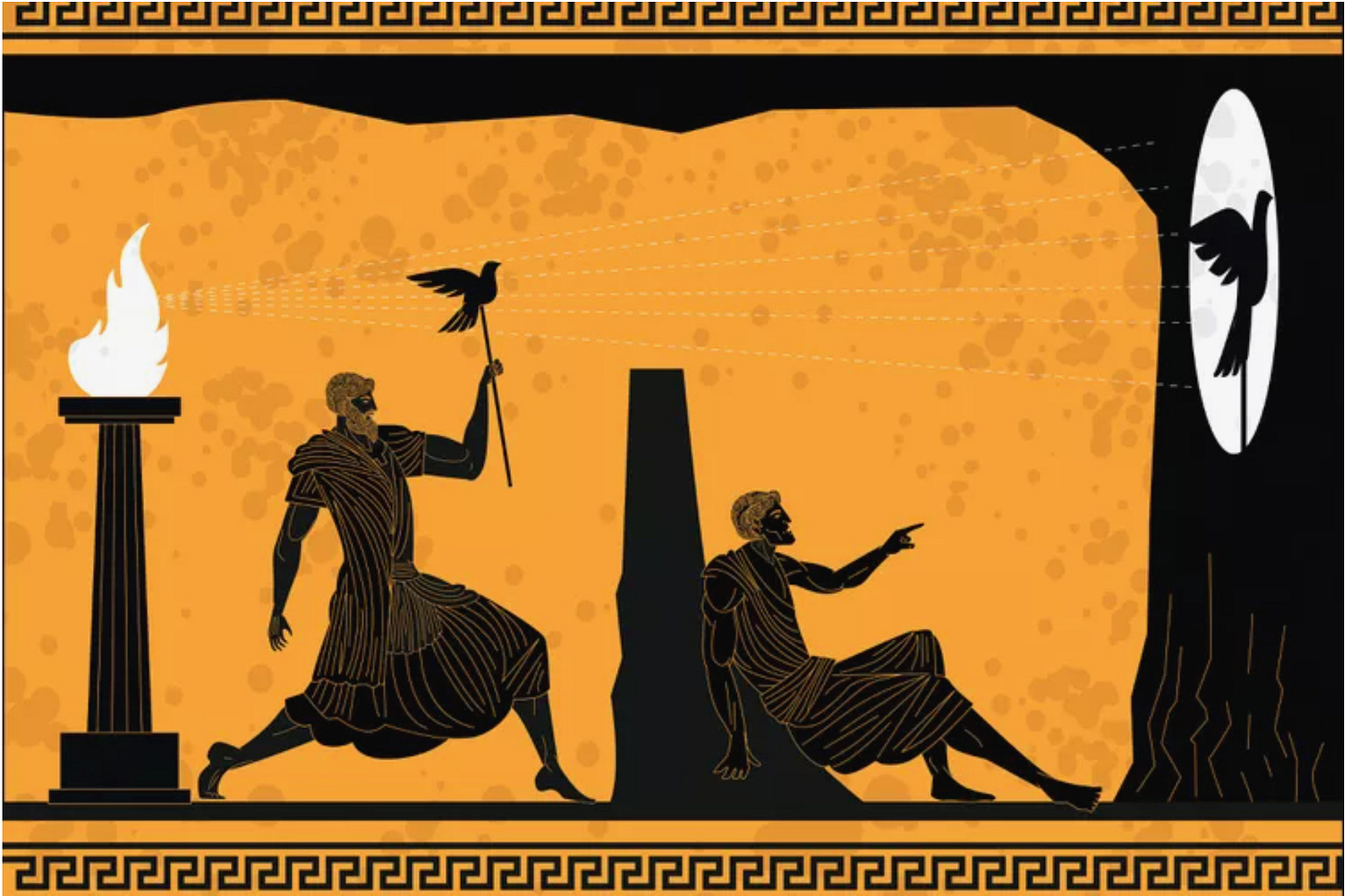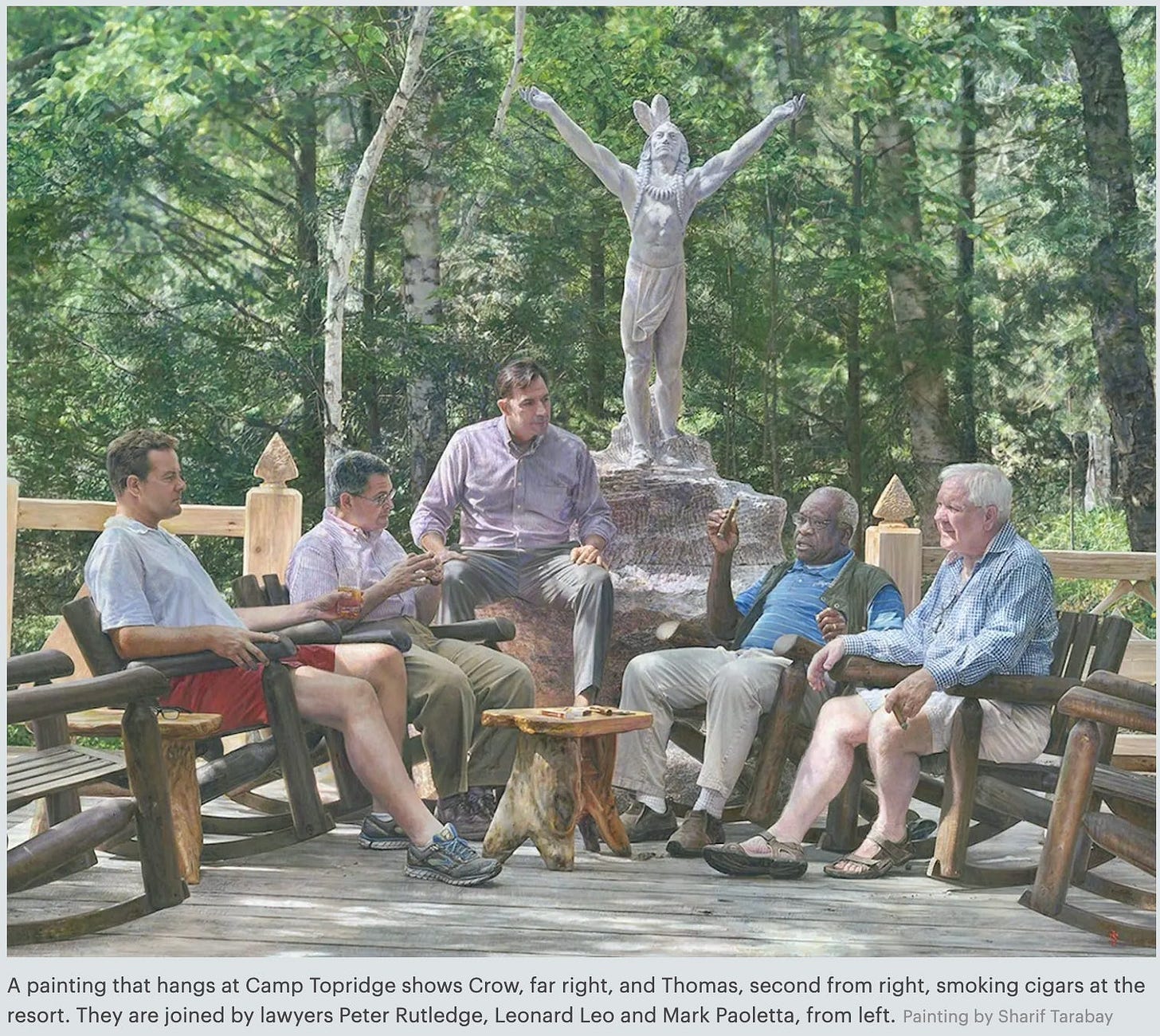Shadows and Shadow Casters
Politics is about power.
Join me on Substack Live today at 1:00 pm ET with Farrah Bostic, researcher, strategist, and host of the “Cross Tabs” podcast, and Friday at 1:00 pm ET with Randi Weingarten, president of the American Federation of Teachers and author of the just-published Why Fascists Fear Teachers. (For more on my Substack Live plans, see the end of this post.)
Last week, I published “Monsters and their Enablers,” where I argue that Donald Trump is less the cause than the consequence of America’s deeper crisis: the successes of the Neo-Confederate coalition, which consists of those who never stopped fighting the New Deal settlement and those who never stopped fighting for white Christian nationalism to rule in America. Enabled by the justices they elevated to the Supreme Court and by decades of Democratic and institutional failure, this coalition has consolidated power across the GOP and much of the country in what I call a war of Southern aggression.
Before turning to that war in future posts, I need to add another important dimension to help describe the complex dynamics driving today’s polycrisis. That is the distinctive but largely ignored role that business and the wealthy play in American politics, even if they are not on board with the white Christian nationalist elements of MAGA’s agenda. (Endnote1)
Shadows and Shadow Casters
Elections decide who will control the coercive authority of the state—who will grow richer and who poorer, whose privileges will be preserved and whose will be curtailed, and how the nation’s vast military power will be imposed onto the rest of the world. So, it should be preposterous to believe that, with stakes so high, billionaires, multinational corporations, and powerful institutions would simply remain on the sidelines, awaiting the verdict of the voters. Yet this is precisely what the prevailing narratives of American politics presume.
A century ago, John Dewey observed that “politics is the shadow cast on society by big business.” Now, in the 21st century, other organized interests—most consequentially the institutional forces of white Christian nationalism, such as Evangelical churches—cast shadows as well. Yet in today’s liberal America, to be taken seriously and to gain a major platform, one must behave as if the shadow itself is the only reality that matters. The shadow-casters are treated as occasional curiosities, but ultimately as inconsequential—and those who insist on calling too much attention to them are dismissed as alarmist, ideological or marginal.
This dynamic means that even essential, deeply researched books like Jane Mayer’s Dark Money, written by respected mainstream reporters with impeccable reputations, can win critical acclaim without disturbing the democratic folktale that voters’ attitudes and politicians’ campaigns alone matter. Such works are quarantined, kept from intruding on the larger stories we tell ourselves about democracy, public debate, and civic life.
This creates a narrow keyhole view of politics. We can see the shadows through that keyhole into the room where we think it happens, but the shadow casters remain out of sight.
Through that keyhole we see only shadows—individual senators and representatives, taking for granted that they were free agents, trading arguments and casting votes. What remains hidden out of view are the shadow casters—the donors, lobbies, and other interests that are the strongest influences on who gets on the ballot, what bills reach the floor, and how narrow the range of “debate” can be. For instance, when people wonder why Democratic leaders don’t have the spine to stand up to Trump, they forget where and with whom they spend most of their time—with funders and business people who for the most part are just fine with what's going on. It’s been widely reported that the DCCC instructs members to spend four hours a day dialing for dollars, while 13,000 lobbyists spend $10 billion every cycle to keep the lines of influence open. And indeed, contrast their behavior today with 2017, when large segments of the business community were interested in containing Trump.
Through that keyhole we see the shadow—the president as a singular leader, elevated by personal vision, rhetorical skill, or electoral mandate. What disappears from sight are the shadow casters—the donors, consultants, media conglomerates, and entrenched interests that shape who can credibly run, how they must campaign, and what policies they can pursue once in power. Even the fiercest critics of presidential overreach often stop short of naming those forces, as if the occupant alone were the author of decisions that serve the architecture of power behind them. Remember that, as I’ve written, when the business community was solidly committed to Trump’s departure in 2020, the Roberts Court shut down all of his efforts to question the election. But in 2024, after key interests had consolidated behind Trump as a candidate, the Roberts Court repeatedly spared no disregard of the plain meaning of the Constitution to intervene on Trump’s behalf. Indeed, his candidacy never would have been viable without that intervention.
Through that keyhole we see the shadows—Supreme Court justices as idiosyncratic individuals, with legibly “conservative” or “liberal” philosophies shaped by their scholarship and personal biography. What disappears from sight are the shadow casters—the Federalist Society and the billionaire and religious interests that created a counter legal establishment to justify their agenda, and groomed, selected, and advanced lawyers and judges who supported that agenda. Even the most withering critics of the Roberts Court—including esteemed law professors whose expertise lies in conventional legal reasoning and who have prominent public platforms—still fall short of admitting that the Roberts Court’s compass points to its progenitors' agenda, not to the jurisprudential consistency and precedent that credentials them.
Politics Is About Power
Especially over the last year, we have focused on a power struggle between abstractions in the three branches of government; this or that is “executive overreach” or a “judicial power grab.” We wonder whether the Supreme Court or Congress will check Trump, in the same way we once wondered whether the Republican Party would check Trump. I’ve already shown how wrong-headed it is to think that the six Republican SCOTUS justices, the Republican House and Senate caucuses, or Trump would ever see themselves as constitutional checks on each other when, in fact, they are teammates, shadows of the same shadowcasters.
Meanwhile, the real power “struggle” has been between the shadow-casters—corporations and their networks of allies—and the rest of us. Struggle in quotes because it has not been much of a struggle—or as Warren Buffett acknowledged nearly 20 years ago, “There’s class warfare, all right, but it’s my class, the rich class, that’s making war, and we’re winning.” To wit:
As working people, we have lost the power to act collectively at work. Arbitration clauses, gutted unions, and underfunded labor boards have left us isolated, unable to bargain effectively, and vulnerable to wage theft, retaliation, and unsafe workplaces. (Endnote2)
As consumers, we have lost the means to hold corporations accountable for fraud, predatory lending, and invasions of privacy. Class actions have been dismantled, regulators have been defunded or captured, and state preemption has stripped our cities of the ability to defend us against abusive financial, data, and retail practices (Endnote3)
As members of communities, we have lost the protections of environmental and public-safety rules that once stood between corporate pollution and our homes. Courts have weakened federal authority, presidents have rolled back safeguards, and legislatures have diverted public funds to fossil fuels while blocking local clean-energy and health initiatives (Endnote4).
Consider how much you’ve read about institutional power grabs, and how little you read about the power being grabbed away from us, let alone the consequences for us and the country. That’s because to put the spotlight on the shadow casters would inevitably call the system’s legitimacy into question. This would, in turn, endanger the sources of power on which the political class depends and lay bare its decades-long failure to warn against, much less stem, the ascendence of the Neo-Confederate project.
Programming Note: Substack Live
Many of you have been joining my weekly Substack Live with messaging expert Anat Shenker-Osorio (my longtime friend and Research Collaborative colleague), usually at 1 PM Eastern. You can find the series of Substack Lives with Anat in a new tab “Meeting the Moment,” on the Weekend Reading homepage.
In order to introduce fresh perspectives as well as to expand Weekend Reading’s scope, I’m going to aim to do an additional one or two Substack Lives a week. You can find my recent Substack Lives with Osita Nwanevu, Perry Bacon, Katherine Stewart, G. Elliott Morris, and Harry Litman in a new tab “Weekend Reading Live” on the Weekend Reading homepage.
If you subscribe to multiple Substacks, I’m sure you’ve been bombarded with invitations to join this or that Substack Live. Unfortunately, most people don’t realize that when you unsubscribe from your email to those notices, Substack unsubscribes you from everything at that publication! Accordingly, we created a separate list for just Substack Live; click here to subscribe or unsubscribe by modifying your email settings. (And, of course, there’s no charge for anything!)
Weekend Reading is edited by Emily Crockett, with research assistance by Andrea Evans.
When I invoke the interests of the “business community” or “plutocrats,” I often hear the objection that corporations and billionaires do not agree on everything. This is true but beside the point. That a group is not monolithic in every way does not disprove that it exists at all. Across the board they do agree on what matters most—lower taxes, weaker regulation, and the continued evisceration of unions. And they act on that consensus through coalitions like the Koch network, the Federalist Society, and ALEC. Trump is making enormous progress on those fronts now, which is why they are not blocking him. Many individual corporations and executives dislike his tariffs and see them as bad for the economy, but business has always been willing to accept that trade-off—see the 1920s or the 1980s.
None of this is to say that business knows or controls everything. Often they make decisions that backfire. German industrialists, for instance, were confident they could manipulate Hitler—until they couldn’t. That Trump may ultimately damage some or all of their interests is not evidence that they had no role in elevating him to power. Nor is it to say that their success was inevitable. To the contrary, their success was very contingent - both on external events (the timing of Supreme Court vacancies) and, as I argue, liberal institutions continuously ignoring or underestimating the threats.
The corporate agenda here has been to suppress collective remedies, expand gig and contractor models, and weaken OSHA and NLRB oversight. The Roberts Court delivered with Epic Systems v. Lewis (2018), Janus v. AFSCME (2018), and Cedar Point Nursery v. Hassid (2021). Congress repealed OSHA’s Volks rule in 2017, and Trump hollowed enforcement by cutting inspectors (GAO found one inspector per 79,000 workers) and blocking a COVID safety rule. Trump 2.0 escalated by firing NLRB member Gwynne Wilcox and pretextually purging staff; see The Trump Regime’s War on Working People for more. Employers gained freedom to squeeze; workers lost both collective voice and basic protections.
The corporate agenda has been to insulate finance and tech from lawsuits and supervision. The Roberts Court delivered with Concepcion (2011), Italian Colors (2013), and TransUnion v. Ramirez (2021), curbing class remedies and standing, even in consumer contracts and antitrust contexts. Congress repealed the CFPB Arbitration Rule in 2017. Under Trump 1.0, CFPB enforcement relief collapsed from $11.8B under Obama to $480M in 2018; the payday underwriting rule was rescinded and the Equifax probe dropped. In Trump 2.0, enforcement cases were simply withdrawn. Consumers lost billions in relief, while corporations gained near-total immunity for predation.
The corporate agenda here has been to limit EPA, DOE, and local governments from constraining fossil-fuel profits. The Roberts Court delivered with West Virginia v. EPA (2022), Sackett v. EPA (2023), and Loper Bright v. Raimondo (2024). Congress repealed the Stream Protection Rule and BLM Methane Rule in 2017. Trump 1.0 froze fuel standards under SAFE, suspended the Chemical Disaster Rule, and gutted WOTUS. Trump 2.0 re-exited Paris, paused 2024 methane and carbon rules, and purged enforcement staff. States joined in with ALEC-driven preemption and scandals like Ohio’s HB6. The winners are fossil and utility firms; the losers are the 177 million Americans living near hazardous facilities and the entire public enduring climate disasters.




I feel deluded and sick. The outsized proportion of these shadow efforts and the length of time they’ve been happening is eye opening to the average person. I knew about the influence of lobbyists and corporations but I didn’t know how extensive and how deep the rot. Realizing it now I think how could we not be in this calamitous situation at this time. It’s been the corporate plan all along and it’s coming to fruition.
We can BOYCOTT